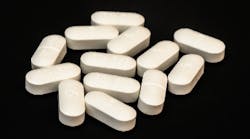Personalized medicine's role in ending opioid abuse in dentistry
Synthetic opioid overdose deaths have increased 72% in the last year. Dentists and oral surgeons are among the biggest prescribers of opioids in the US, so personalized medicine profiles that analyze genetic markers and other risk factors—assessing opioid use disorder risk before treatment and thus before prescribing opiates—to provide individual treatment options for patients are welcome news for dentistry.
Health-care workers are well aware of the widespread chronic pain epidemic in this country, which is undoubtedly linked to rampant prescription opioid abuse and overdose. This serious problem costs our national health-care system hundreds of billions annually and negatively impacts the lives of many patients and their families. The data is clear that current efforts to help solve this epidemic are failing as the Centers for Disease Control and Prevention (CDC), in a December 2016 report, documented that synthetic opioid overdose deaths have increased 72% in the last year alone.
This national crisis has been particularly troubling to clinicians in dentistry, who have long been void of treatment options for pain that do not involve the major risks associated with opioid pain medications. However, with the dawn of evidence-based, individualized precision medicine testing, dentists can now effectively assess patient vulnerability toward opioid misuse, as well as determine the best opioid or nonopioid medications to prescribe for safe, effective pain relief, while avoiding potential addiction or harmful side effects.
Dentists and oral surgeons are among the biggest prescribers of opioids in the United States, accounting for 12% of all instant-release opioids, according to the American Dental Association. Yet, shockingly, dental professionals face a substantial lack of pain management training, with only 15 hours of pertinent education during dental school. As a result, attempting to treat patients with chronic or acute pain, due to issues such as temporomandibular joint disorder (TMJD) and tooth extraction surgeries, can be a guessing game that leaves abuse, addiction, and physical damage in its wake.
This of even greater concern for younger patients, who commonly face wisdom tooth extraction, which exposes many of them to opioids for the first time. Studies indicate that this demographic is highly susceptible to pain pill addiction, with some progressing to heroin, which provides the same euphoric high. Unsurprisingly, overdoses among teens and those in their 20s increase every year. According to a report from Trust for America’s Health, the drug overdose death rate has more than doubled during the past decade among people ages 12 to 25, rising from 3.1 deaths per 100,000 in 1999–2001 to 7.3 deaths in 2011–2013. (1)
There is good news though. With the aid of groundbreaking, personalized medicine profiles that analyze genetic markers and other nongenetic risk factors of individual patients, pain medicine prescribers—such as dentists—can accurately assess drug metabolism, evaluate pain sensitivity, predict response to opioid and nonopioid pain medications, avoid adverse drug events, and identify predisposition for opioid use disorder. These evidence-based advances can eliminate risk of treatment failure, decrease costs to insurers, and decrease addiction rates.
Proove Biosciences is an example of one company that has developed evidence-based methods for assessing opioid use disorder risk before treatment and thus before prescribing opioid medications, as well as providing personalized treatment options for those suffering from TMJD, which affects approximately 10 million Americans.
The Proove Comprehensive Opioid Risk, Response, and Side Effects Profile
This precision medicine profile provides three key pieces of information for those prescribed opioids:
- Risk of opioid misuse
- Personalized opioid treatment recommendations
- Risk of opioid-induced side effects and personalized treatment options for those suffering from these side effects
This information can be used clinically, along with a medical evaluation of therapeutic outcomes, to guide opioid selection, dosage decisions, and treat side effects.
The Proove TMD Profile
This test elucidates the underlying mechanisms involved in TMJD pain, including genetic variants in the adrenergic and serotonergic pathways, as well as patient self-reported stress and tender points to provide personalized insights into the pathways involved in the individual patient.
This profile offers clinicians the ability to pinpoint individualized treatment solutions based on a patient’s specific type of TMJD pain.
When such tests are implemented in a clinical setting, the benefits for all involved can be substantial. Not only will they serve to offer better outcomes for patients—including optimal pain management and safe, lasting relief—but doctors can also eliminate the painstaking process of tweaking treatment options and lessen the risk of ineffective and potentially harmful prescriptions.
We are experiencing an inflection point in the medical field where the modern advances in medical science derived from the use of genetic information intersects with advances in big data and predictive analytics to provide a level of analysis that will forever transform the way we diagnose and treat suffering patients. With the completion of the Human Genome Project in 2003 came a whole new way of studying our complex, 40 billion-year-old DNA. Since then, doctors and scientists have been able to better understand and tend to traditionally difficult-to-treat disorders.
In the history of health care, dental or otherwise, there has never been more valuable and detailed information at our fingertips. When harnessed, this genetic data can be combined with other individual factors and data points on patients to benefit individual patient outcomes, as well as outcomes for physicians and insurers. Over time, precision medicine testing will eliminate unnecessary prescriptions and overprescription of opioid medications, leading to a healthier, less painful world where abuse and overdose is finally on the decline.
Reference
1. Thompson D. Drug overdose rates soaring among US youth. Trust for America's Health. http://healthyamericans.org/newsroom/news/?newsid=3197. Published November 19, 2015. Accessed April 7, 2017.

